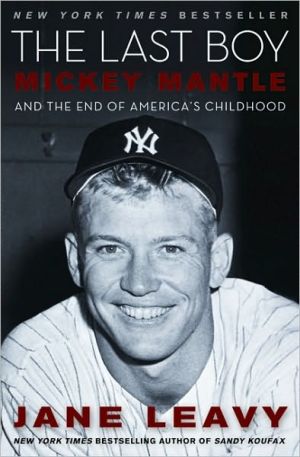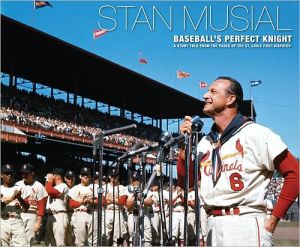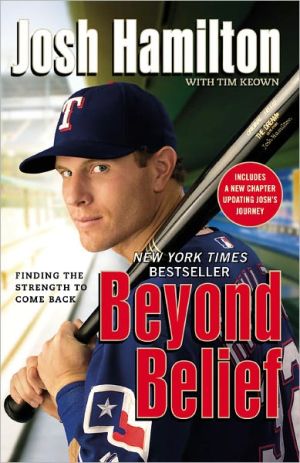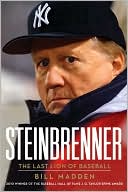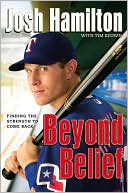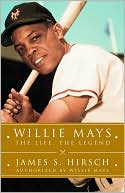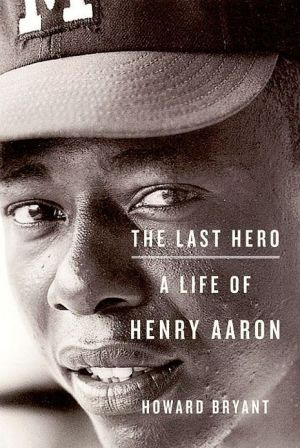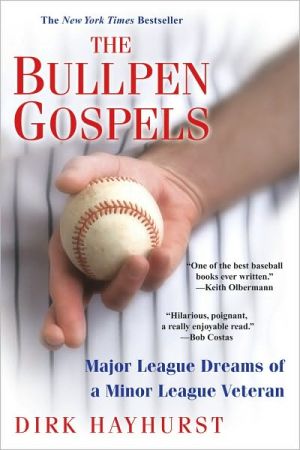The Last Boy: Mickey Mantle and the End of America's Childhood
""In Leavy's hands, the life of Mantle no longer defies logic: it seems invitable, She's hit a long home run."---Publishers Weekly (starred review) "A masterpiece of sports biography."---Booklist (starred review)" "Mickey Mantle's sweater hangs on the door to my office. I put it there the day I decided to write this book... It has followed me from closet to closet and house to house since he gave it to me twenty-seven years ago. I packed it away in an old garment bag right after I said...
Search in google:
Jane Leavy, the acclaimed author of the New York Times bestseller Sandy Koufax: A Lefty's Legacy, returns with a biography of an American original—number 7, Mickey Mantle. Drawing on more than five hundred interviews with friends and family, teammates, and opponents, she delivers the definitive account of Mantle's life, mining the mythology of The Mick for the true story of a luminous and illustrious talent with an achingly damaged soul. Meticulously reported and elegantly written, The Last Boy is a baseball tapestry that weaves together episodes from the author's weekend with The Mick in Atlantic City, where she interviewed her hero in 1983, after he was banned from baseball, with reminiscences from friends and family of the boy from Commerce, Oklahoma, who would lead the Yankees to seven world championships, be voted the American League's Most Valuable Player three times, win the Triple Crown in 1956, and duel teammate Roger Maris for Babe Ruth's home run crown in the summer of 1961—the same boy who would never grow up. As she did so memorably in her biography of Sandy Koufax, Jane Leavy transcends the hyperbole of hero worship to reveal the man behind the coast-to-coast smile, who grappled with a wrenching childhood, crippling injuries, and a genetic predisposition to alcoholism. In The Last Boy she chronicles her search to find out more about the person he was and, given what she discovers, to explain his mystifying hold on a generation of baseball fans, who were seduced by that lopsided, gap-toothed grin. It is an uncommon biography, with literary overtones: not only a portrait of an icon, but an investigation of memory itself. How long was the Tape Measure Home Run? Did Mantle swing the same way right-handed and left-handed? What really happened to his knee in the 1951 World Series? What happened to the red-haired, freckle-faced boy known back home as Mickey Charles? "I believe in memory, not memorabilia," Leavy writes in her preface. But in The Last Boy, she discovers that what we remember of our heroes—and even what they remember of themselves—is only where the story begins. The Barnes & Noble Review The schizophrenic quality of Mickey Mantle's life is made powerfully manifest throughout Jane Leavy's exhaustively researched, delightfully readable biography. Right from the start, Mantle's enormous athletic potential was bundled with his debilitating psychological and physical problems. Leavy not only wrestles with the maddening contradictions of the man himself but also the carefully-constructed myth of Mantle: that the Yankee slugger, by pure willpower, transcended humble beginnings and a lifetime of physical pain to become an American icon. But she keeps her eye on more than the facts of her subject's life, recognizing that fans and writers (herself included) have "invent[ed] a kinder, warmer, bigger Mick, the Mick
The Last Boy\ Mickey Mantle and the End of America's Childhood \ \ By Jane Leavy \ Harper Perennial\ Copyright © 2011 Jane Leavy\ All right reserved.\ ISBN: 9780060883539 \ \ \ Chapter One\ March 26, 1951\ The Whole World Opened Up\ On March 20, 1951, shortly after arriving in Los Angeles for the \ beginning of their spring training tour of California, the World Champion \ New York Yankees visited the lot at MGM where Betty Grable was \ rehearsing dance numbers for her newest flick. A PR still, later published \ in Movie Fan magazine, was taken to commemorate the occasion. There's \ Yogi Berra front and center wearing a garish paisley sports shirt as bright \ as his smile, with a collar as wide as his ears and Grable on his well\ tailored arm. There's The Scooter, Phil Rizzuto, the unlikely MVP of the \ 1950 season, and his double-play partner, second baseman Jerry Coleman;\ Johnny Hopp, Johnny Mize, and big Joe Collins offering Grable his \ right arm.\ In the back row, like a schoolboy who'd wandered into the wrong class \ picture, stands the rookie Mickey Mantle, his features as unformed as his \ future. He gazes over Grable's shoulder, his blond hair smartly parted, \ cowlick neatly slicked, necktie tautly knotted.\ Mantle and his roommate, Bob Wiesler, were the only rookies in the \ bunch, both movie buffs. They couldn't understand why more of the \ veteran players hadn't jumped at the chance to go to Hollywood. They \ met Esther Williams, Red Skelton, Howard Keel, and the guy who later \ played Miss Kitty's bartender on Gunsmoke. They saw Debbie Reynolds \ hurrying down the hall carrying two fur coats and called out, "Hiya, \ Deb!" Mantle wrote home to his Oklahoma sweetheart about the starlets \ who returned his hello. "Wasn't any as pretty as you."\ It was a big time for Mickey Mantle. His childhood friend from Commerce,\ Nick Ferguson, who had migrated west after high school, drove up \ from San Diego in his old '42 Plymouth to show him the California coast. \ Ferguson wanted his Okie buddy to see the Pacific. They went straight \ out Wilshire Boulevard to the Santa Monica Pier. It was Mantle's first \ opportunity to feel the surf and sand between his toes. But he did neither. \ Baseball was the only thing on his horizon. All he cared about was getting \ to the ballpark on time.\ Del Webb, the Yankees' entrepreneurial co-owner, had contrived that \ spring to switch training camps with the New York Giants. Webb was a \ Phoenix real estate developer, ahead of his time in grasping the westward \ rush of postwar America. Sporting News reported that he was considering \ selling his stake in the Yankees to his partner Dan Topping as part of a \ plan to extend major league baseball beyond the Mississippi.\ Bringing the Yankees to train in Phoenix allowed him to play the big \ shot in his hometown. Then he sent them barnstorming up and down \ the California coast in order to showcase Joe DiMaggio in the Clipper's \ home state and whet the appetite for big league ball. The schedule called \ for thirteen games in California, mostly against Class AAA Pacific Coast \ League teams, with stops at Glendale, manager Casey Stengel's hometown;\ in Oakland, where Stengel had managed the Oaks before being \ promoted to the Yankees' job; at Seals Stadium in San Francisco, where \ DiMaggio had made his name; and finally at the University of Southern \ California against the Trojans, better known for their gridiron exploits. \ That spring was the last time the Yankees would train anywhere other \ than Florida.\ It also marked the opening act of one of baseball's—or Broadway's—\ greatest hits, an SRO psychodrama with a very long run.\ Stengel had seen Mantle for the first time a year earlier at a prespring \ training camp held in Phoenix for the top prospects in the Yankees system.\ The kid, just eighteen, had missed the team bus to the practice field. \ He was standing with a teammate, Cal Neeman, neither of them knowing\ what to do, when a taxi pulled up. "Well, hop in, boys," Stengel said, \ "we'll go to the park."\ Neeman recalled, "And we're ridin' along, and he wants to know who's \ in the car. Well, we really didn't want to tell him. I give him my name. He \ come to Mickey and says, 'Who are you?' And he says, 'I'm Mickey.' And \ he says, 'Oh, you're that kid that's all mixed up. You're not supposed to be \ able to run like that and hit the ball so far.' "\ Mantle was all but invisible until the coaches said, "Take your \ marks . . ." Hank Workman, a prospective first baseman, recalled, "They \ were timing guys from home to first. Nobody noticed Mantle up to that. \ He was very quiet and extremely shy. He would pull his cap down so far \ over his brow that you could hardly see his face. Then he ran. And I swear \ he was going so fast you could still see the tufts of dust in the air from his \ footprints a couple of feet back from where he was."\ Bunny Mick, one of Stengel's lieutenants, timed him from the left-\ handed batter's box to first base in 3.1 seconds, a new land-speed record.\ Workman also recalled Mantle's debut in intrasquad games: "The first \ time Mantle came up, he hit one a mile outta that ballpark. About three \ innings later he comes up again. The pitcher's changed, and he hits one a \ mile out the other way. And all he does after is, he trots out to shortstop \ in his non-ostentatious way with his hat pulled way down."\ The camp was shut down when Commissioner Happy Chandler got \ wind of the big league instructors getting a head start on spring training. \ But Stengel had seen enough to see the future. "Mantle's at shortstop \ taking ground balls, throwing 'em by the first baseman—and outta the \ dugout comes Stengel," Workman remembered. "He's got a fungo bat in \ his hand, and he runs right at Mantle. He starts waving this bat at him, \ and he shoos him out into the outfield, and turns around and loudly \ announces to all the coaches and everybody that's assembled that this guy \ is gonna be a center fielder. 'I'm gonna teach him how to play center field \ myself, and I don't wanna see him at shortstop again.' "\ But that's where he played for the 1950 Joplin Miners. His .383 batting\ average deflected attention from his 55 errors and he was named the \ \ \ Most Valuable Player of the Western League. In January 1951, The Sporting\ News hailed him as a "Jewel from Mine Country."\ "Nineteen-year-old Mickey Mantle, dubbed by some big time scouts \ as the No. 1 prospect in the nation, will be off for Phoenix in a few weeks \ to display the talents that won him such raves from veteran talent hunters,"\ baseball writer Paul Stubblefield declared. And in a special box, The \ Sporting News announced the engagement of the Yankees' big catch—\ who "didn't cost a nickel"—to Miss Merlyn Louise Johnson of Picher, \ Oklahoma.\ The groom to be was a no show when rookies reported to spring training\ camp two weeks later. A reporter and photographer from the Miami \ Daily News-Record found Mantle at the Eagle-Picher motor pool and\ delivered a message from Yankee farm director Lee MacPhail: "Where are \ you?"\ Helping out the pump crew, came the reply, for $33 a week. \ The Yankees hadn't sent him a train ticket, and Mantle wasn't a bonus baby like\ Skowron ($25,000) and Kal Segrist ($50,000). His half brother, Ted \ Davis, used his Army discharge money to pay for Miss Johnson's engagement\ ring. The photographer snapped a picture of the overall clad prospect\ with the smudged grin leaning against a mining company truck. The \ next day, Tom Greenwade, who would forever be known as the scout who \ signed Mickey Mantle, showed up with his fare.\ By the time Mantle got off the train in Phoenix, the Yankees' most \ heralded rookies—Bob Wiesler, Moose Skowron, Gil McDougald, Andy \ Carey, and Bob Cerv—were working on their baseball tans. They never \ forgot those early tastes and smells of the big time. For Al Pilarcik, an \ outfielder from Ohio, it was the scent of orange blossoms from the trees \ outside the team's motel. For Wiesler, it was the standing rib roast that \ circulated through the dining room on a rolling cart. Every night, waiters \ would lift the platter's heavy silver-plated hood and the kids would help \ themselves to a juicy slab of promise.\ The early reports on Mantle were measured in tone. He was being \ groomed, considered, studied. Neither he nor his employers expected him \ to play in the big leagues in 1951. Never had anyone in the Yankee system \ made the leap from Class C to the majors after only two years in professional\ baseball. And Jackie Jensen, the California golden boy, was also \ waiting in the wings for DiMaggio to exit stage right.\ But Stengel was watching, keeping a close eye on his new kid. "We'd \ go down through the lobby, Casey would always be sittin' there," Nick \ Ferguson said. "And he never said anything, but he was eyeballin' me like \ he knew I wasn't a player, and what was I doin' there with Mickey?"\ Spring is a season of profusion, especially for baseball writers, the \ inevitable consequence of sending grown men to Florida and Arizona \ with empty notebooks, a per diem—and no wives. Red Smith rued the \ day he received a wire from Stanley Woodward, his editor at the New \ York Herald Tribune, ordering him to quit "godding up those ballplayers."\ Nonetheless, in the spring of 1951, Mickey Mantle was elevated and \ beatified.\ In the thin Arizona air, his home runs soared and florid prose burst \ forth from fallow typewriters like desert wildflowers. Just a week after \ Mantle arrived in camp, Ben Epstein, the effusive beat writer for the New \ York Daily Mirror, wrote, "Thank the fates for Arizona's ambrosial air. It's \ practically necessary to fuel one's lungs with the stuff if you want to stay \ in fashion and carry on about Mickey Mantle. Latest estimates hoisted \ the Yankee oakie doakie as the eventual successor to Joe DiMaggio."\ Bad weather during the first days of camp—snow, even—forced the \ players indoors. Indolent scribes still had to churn out copy. Encomiums \ lit up the Western Union wires: "Rookie of the Eons,"\ "Magnificent Mantle," "Mighty Mickey," "Young Lochinvar," "Commerce Comet," \ "Oklahoma Kid," "Colossal Kid," "Wonder Boy," "One-Man Platoon," "The \ Future of Baseball."\ Pete Sheehy, the clubhouse man and guardian of Yankee succession, \ assigned the lockers and the uniform numbers—the Yankees were the first \ team to do that. Sheehy had gone to work for the club when he was fifteen, \ summoned to his calling while waiting for the Stadium gates to open one \ day in 1927—and stayed until his death fifty-nine years later. The Yankee\ locker room is named after him. He was the institutional memory of \ the club, who divulged nothing. He fetched hot dogs and bicarb for The \ Babe and joe for Joe D.; he informed a historically challenged rookie that \ George Herman Ruth's number 3 was not available, nor was Henry Louis \ Gehrig's 4. As for 5, everyone knew 5 was still working on immortality. \ Sheehy gave Mantle 6. "The law of mathematical progression," the Yankees'\ public relations man Red Patterson called it.\ Veterans reported on March 1. Archie Wilson, an outfielder \ returning from military service, arrived to find both beds in his \ assigned room taken. Archie's widow, Sybil Wilson, recalled that as her \ husband put his things down on a roll-away, Mantle rose from his bed \ and said, "You're not going to sleep on the cot." He would take it—\ Wilson was an Army vet and his senior.\ On March 2, Stengel announced that he was moving Mantle to the \ outfield. The next day, DiMaggio announced that the 1951 season would \ be his last. His throwing shoulder was sore, his left knee was swollen, and \ his pride was smarting. All those questions didn't help, either. Louella \ Parsons, the dominatrix of Hollywood gossip, wanted to know about a \ possible reconciliation with his estranged wife, Dorothy. The baseball \ writers wanted the dope on the new kid. So DiMaggio threw them all \ a curve.\ His retirement was on the horizon, but the Yankees had no idea an \ announcement was coming that day. "What am I supposed to do, get a \ gun and make him play?" Stengel groused. Overnight, Mantle went from \ a good story to the story. "When they'd go into the hotel lobbies, all the \ newspaper people would flock to Mickey," Sybil Wilson recalled. "He \ would get down behind Archie and squat down so they wouldn't see him. \ He was so scared of them."\ Tommy Henrich, Old Reliable, was assigned the task of turning him \ into an outfielder, teaching him how to gauge the angle of the ball off the \ bat; how to position his body to catch the ball on his back foot and get rid \ of it in one smooth motion; how to react to a drive hit straight at him. His \ arm was plenty strong—legend had it that minor league ballparks refused \ to sell tickets behind first base when Mantle was patrolling the infield or \ put chicken wire up to protect the spectators. Delbert Lovelace, a friend \ from sandlot ball back home, was on the receiving end of more than one \ errant heave: "One time he let the ball loose, and it looked like surely that \ ball was goin' to drop into the dirt, and I put my glove down, and it hit \ me on the wrist above my glove." \ The seams of the baseball were engraved in his flesh.\ \ (Continues...)\ \ \ \ \ Excerpted from The Last Boy by Jane Leavy Copyright © 2011 by Jane Leavy. Excerpted by permission of Harper Perennial. All rights reserved. No part of this excerpt may be reproduced or reprinted without permission in writing from the publisher.\ Excerpts are provided by Dial-A-Book Inc. solely for the personal use of visitors to this web site. \ \
Preface: My Weekend with The MickPART ONE Innocence Lost, Atlantic City, April 19831 March 26, 1951: The Whole World Opened Up 72 October 5, 1951: When Fates Converge 203 October 23, 1951: Undermined 384 May 27, 1949: Patrimony 495 May 20, 1952: In the Ground 716 April 17, 1953: One Big Day 837 November 2, 1953: Fish Bait 1038 September 26, 1954: No Other Time 122PART TWO A Round with The Mick, Atlantic City, April 19839 May 30, 1956: A Body Remembers 14910 May 16, 1957: Returns of the Day 16311 August 14, 1960: Season Under Siege 186PART THREE Nightcap, Atlantic City, April 198312 September 25, 1961: Dr. Feelgood 21013 May 18, 1962: His Best Self 23314 June 5, 1963: The Breaking Point 24815 September 26, 1968: Last Licks 264PART FOUR Dream On, Atlantic City, April 198316 June 8, 1969: Half-life of a Star 29017 December 19, 1985: 18 Below in Fargo 30618 February 5, 1988: Top of the Heap 32719 Febraury 4, 1994: Getaway Day 339PART FIVE Riding with The Mick, Atlantic City, April 198320 August 13, 1995: The Last Boy 362Epilogue 385Acknowledgments 389Appendix 1 Interview List 395Appendix 2 The Kinetic Mick 405Appendix 3 Who's Better? 417Bibliography 421Index 439
\ From Barnes & NobleMickey Mantle (1931-1995) was a baseball legend determined to remain a legend. He wrote or pretended to write six baseball autobiographies, each of which presented a stylized portrait of the switch-hitting Yankee centerfielder. What remained obscured behind the imposing statistics and the diamond myth was the real Mantle himself. That absence was filled partially by a family confessional that described their collection descent into alcoholism and drug abuse, but in many ways, the mist still remained. Finally, after decades, Washington Post sportswriter and author (Sandy Koufax) has given us a vibrant biography of the man behind the pinstripes, drawing on more than 500 interviews with The Mick's family, friends, teammates, and other players. A Barnes & Noble bestseller now in paperback and two NOOK Book editions.\ \ \ \ \ \ Publishers WeeklyBob Costas eulogized the Yankee great as "a fragile hero to whom we had an emotional attachment so strong and lasting that it defied logic." The "we" in Costas's remarks--with author Leavy (Koufax: A Lefty's Legacy) as stand-in--is as much the subject of this fascinating biography as the ballplayer himself. Mantle, who succumbed to cancer in 1995 at age 63, was justly famous for his baseball exploits, but what Costas described as Mantle's "paradoxical grip" on a certain generation of baseball fans is exactly what Leavy tackles in this book. She should know. She spent much time in her childhood in the shadow of Yankee Stadium, a tomboyish "Mickey guy" listening to the roar of the crowd from across the Grand Concourse. While a sportswriter for the Washington Post, she won a 1983 assignment to interview Mantle for his upcoming golf tournament in Atlantic City. What happened that day and night between the fading, embittered Mantle and the former fan girl trying to do her job is the drama that structures Leavy's narrative--she has never reported the truth till now, and she does so without judgment. Instead, she proceeds with steely determination to understand what brought this onetime golden boy from the zinc mines of Oklahoma to center stage at Yankee Stadium and made him into America's quintessential tragic hero, a freakily gifted athlete haunted by a deadly genetic inheritance, including alcoholism. With storytelling bravado and fresh research, Leavy weaves around her own story the milestone dates in "the Mick's" career, which as often burnishes the legend as tarnishes it. Leavy concludes that Mantle cavorted in a more innocent time, when people believed in sports heroes and would not hear otherwise. That's hardly a new idea, but no matter: by the end of this book, readers will know what made Mantle rise, fall, and survive into recovery for his last 18 months. In Leavy's hands, the life of Mantle no longer defies logic: it seems inevitable. She's hit a long home run. 8 pages of color and 8 pages of b&w photos. (Oct.)\ \ \ Library JournalMickey Mantle was a sensitive country boy who was both blessed and cursed. Blessed with a level of natural ability and a twist of fate that made him into a baseball legend at age 21. Cursed by injuries and by the unattainable set of expectations that came with being cast in the role of America's hero. A shy person at heart, he coped with the glare of the spotlight in the traditional ways: via alcohol and sexual profligacy. Author Leavy (Sandy Koufax: A Lefty's Legacy) conducted years of research and interviewed hundreds of people. As a sports writer for the Washington Post in the 1980s, she even interviewed the man himself on several occasions. What sets Leavy's work apart from other Mantle biographies is the framework of personal memories—her own, growing up in the Bronx during Mick's heyday, interspersed with details from 20 selected days that reveal "flashpoints" from Mantle's turbulent personal life.Verdict Leavy's well-crafted portrait of this American hero evokes a range of emotion—admiration, disdain, and compassion—regarding a man who carried some mighty burdens upon his broad shoulders. Recommended for baseball fans and for the Yankee faithful. (Photos not seen.) [See Prepub Alert, LJ 12/1/09.]—Susanne Wells, P.L. of Cincinnati & Hamilton Cty.\ \ \ \ \ Kirkus ReviewsAnother biography of the late Yankee slugger—but this candid, compassionate portrait is worth a dugout full of the others.\ Sports journalist Leavy (Sandy Koufax, 2002) produces an enduring, though certainly not endearing, portrait of The Mick. Eschewing traditional chronology, the author begins with a 1983 interview she conducted with the boozy, boorish, lecherous Mantle (he'd been retired for 15 years), an experience she spreads throughout the narrative, using portions of it to introduce each major section. She focuses on 20 significant days in Mantle's life (five of them after his playing days), beginning with his career-threatening injury in 1951 in Yankee Stadium, and ending with his death to cancer in 1995. In between are glimpses of Mantle as son, brother, husband, adulterer (he was a serial offender), father (not a good one), player, teammate and fading and feckless celebrity. Leavy is generally careful not to celebrate his athletic accomplishments excessively, though it's hard not to. His home runs were prodigious; his speed was gazelline; his capacity to endure pain was humbling. He won the Triple Crown in 1956 and entered the Hall of Fame as soon as he was eligible. The Mick, however, harbored many demons, and the author justly emphasizes them when appropriate. Often ignorant, capricious and extremely self-centered, he drank heavily, cheated on his wife and could be crude and obnoxious to fans (some of the things he wrote on souvenirs for young hero-worshippers—e.g., "You're lucky. Your mom has nice tits"—are legendary). But as Leavy points out, it was in no one's pecuniary interest to portray Mantle as anything other than the All-American Ballplayer.\ The best of the Mantle biographies.\ \ \ \ \ \ Keith Olbermann…Leavy comes as close as perhaps anyone ever has to answering "What makes Mantle Mantle?" She transcends the familiarity of the subject, cuts through both the hero worship and the backlash of pedestal-wrecking…treats evenly his belated sobriety and the controversial liver transplant…and handles his infidelity with dispassion. Sophocles could have easily worked with a story like Mantle's—the prominent figure, gifted and beloved, through his own flaws wasteful, given clarity too late to avoid his fate. Leavy spares us the classical tragedy even as she avoids the morality play. The Last Boy is something new in the history of the histories of the Mick. It is hard fact, reported by someone greatly skilled at that craft, assembled into an atypical biography by someone equally skilled at doing that, and presented so that the reader and not the author draws nearly all the conclusions.\ —The New York Times\ \ \ \ \ Booklist"A masterpiece of sports biography."\ \ \ \ \ Philadelphia Inquirer"[The Last Boy] is a tale deftly told, rich in detail, unvarnished and unsparing, researched to a fare-thee-well, alternatively fluid and florid, and without staleness because Leavy has found a new angle from which to come at a well-worked-over subject."\ \ \ \ \ Booklist (starred review)“A masterpiece of sports biography.”\ \ \ \ \ New York Newsday"Engrossing.… The Last Boy is a fresh, thorough examination of Mickey Mantle’s life."\ \ \ \ \ Time magazine“Leavy shows Mantle at his unfathomable worst and unrecognized best. For even the most ardent Mantleologist, The Last Boy, is an education.”\ \ \ \ \ Boston Globe"Do not walk—sprint—to the bookstore to get a copy of The Last Boy."\ \ \ \ \ Salon.com"Part biography, part memoir, and part fan’s note, The Last Boy is the most complete book ever about Mantle."\ \ \ \ \ Sports Illustrated"Definitive."\ \ \ \ \ Keith Olberman"The Last Boy is something new in the history of the histories of the Mick. It is hard fact, reported by someone greatly skilled at that craft...and presented so that the reader and not the author draws nearly all the conclusions."\ \ \ \ \ Joe Torre"Every kid growing up in New York in the ‘50s wanted to be Mickey Mantle, including me.... Jane Leavy has captured the hold he had on all of us in this gripping biography."\ \ \ \ \ Time Magazine"Leavy shows Mantle at his unfathomable worst and unrecognized best. For even the most ardent Mantleologist, The Last Boy, is an education."\ \ \ \ \ Doris Kearns Goodwin"This is one of the best sports biographies I have ever read. Beautifully written and thoroughly researched, it reveals with stunning insight both the talents and the demons that drove Mickey Mantle, bringing him to life as never before."\ \ \ \ \ Tom Verducci"In sharp detail and graceful style, Leavy cuts through the myth and treats us to a rarely known Mantle: more flawed, more human and more likeable. A terrific read."\ \ \ \ \ Daniel Okrent"The only thing about this book that is better than Jane Leavy’s vivid prose is her astonishing reporting. To my knowledge, no one has ever investigated the life of an American athlete with Leavy’s rigor and thoroughness."\ \ \ \ \ David Maraniss"The Last Boy is stunning. Jane Leavy captures the beautiful, imperfect Mickey Mantle with equal measures of depth and empathy. She finds the buried answers to the riddle of what drove and haunted the Mick."\ \ \ \ \ The Barnes & Noble ReviewThe schizophrenic quality of Mickey Mantle's life is made powerfully manifest throughout Jane Leavy's exhaustively researched, delightfully readable biography. Right from the start, Mantle's enormous athletic potential was bundled with his debilitating psychological and physical problems. Leavy not only wrestles with the maddening contradictions of the man himself but also the carefully-constructed myth of Mantle: that the Yankee slugger, by pure willpower, transcended humble beginnings and a lifetime of physical pain to become an American icon. But she keeps her eye on more than the facts of her subject's life, recognizing that fans and writers (herself included) have "invent[ed] a kinder, warmer, bigger Mick, the Mick [we] wanted him to be."\ Mantle's distant father, like several Mantles, died young, leaving Mickey a sense of abandonment and a fatalistic streak. Once his ballplaying career took off, he found himself saddled with excruciating pain from multiple on-the-field injuries. Despite these physical and psychological problems, his wounds were largely cloaked -- the press and public celebrated Mantle as a shimmering example of American manhood. As Yankee wife Lucille McDougald tells Leavy, "Who wouldn't hop into bed with him?" Married with children, Mantle loved the nightlife, drinking and chasing beautiful women (or in Mantle's case, being chased). Much like his battle-scarred knees, his liver and his marriage almost collapsed under the exertion.\ Leavy interviewed everyone close to Mantle. The slugger's hyper-forgiving wife, Meryl, tells Leavy that "[h]e thought no one ever loved him." The Last Boy's most telling revelation may be in Mantle's sexual abuse as a boy, a trauma which made him largely incapable of trusting others. When Leavy interviewed the retired Mantle, he was drunk and made a pass at her. She also watched Mantle telling numerous dirty jokes and off-color anecdotes. The tragedy Leavy exposes is that Mantle only confronted his present problems, and damaged childhood at the end of his life. If we like our heroes because of, not in spite of, their frailties, then Mickey Mantle may be the greatest hero of all. Leavy gives us Mick, not necessarily as fans have wanted to see him, but still glorious in all his self-destructive, splendid complexity.\ --Chuck Leddy\ \ \
